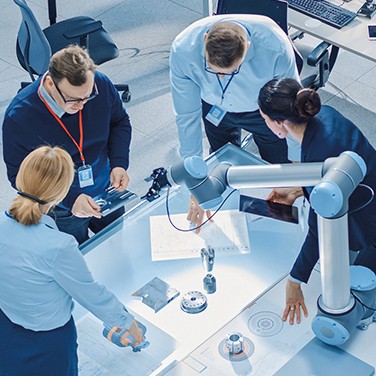Inspire Innovation with the Right Lab Design
By Gina Wynn
The way we conduct scientific research has evolved and so has the idea of a productive lab environment. Now that scientists are taking a more multidisciplinary approach to research, design experts are developing spaces that complement the scientific team structure. Cutting-edge building designs take collaboration, flexibility, and wellness into account in order to foster a culture that inspires innovation.
The Multidisciplinary Movement
Researchers looking to make advancements in their areas of study are realizing that there are benefits to bringing together biologists, chemists, computer scientists, economists, engineers, medical professionals, physicists, and other experts from various disciplines to contribute their knowledge and opinions.
Coined “convergence research” by Massachusetts Institute of Technology (MIT) scientists, the concept has the support of the National Science Foundation (NSF) and is considered a revolution in the life sciences by many academics. In 2016, the NSF identified “growing convergence research” as one of 10 Big Ideas for Future NSF Investments.
Cultivating Collaboration
To facilitate this paradigm shift in research practices, designers are rethinking traditional lab workspaces to cultivate environments conducive to collaboration. It’s becoming the norm to house groups from different specialty areas in the same building where they have shared access to common gathering spaces. Cafes and snack areas with comfortable seating encourage informal conversations and spark creativity among people of different backgrounds.
A University of Michigan study shows that this practice can produce positive results. “Researchers who occupy the same building are 33 percent more likely to form new collaborations than researchers who occupy different buildings, and scientists who occupy the same floor are 57 percent more likely to form new collaborations than investigators who occupy different buildings,” according to Toni Loiacano in her article “A Revolution in the Creation of Scientific Workplaces” for Scientific American.
"Scientists who occupy the same floor are 57 percent more likely to form new collaborations than investigators who occupy different buildings."
Design firms have already been optimizing their floor plans to take advantage of these benefits. CannonDesign developed the concept for CJ Blossom Park in South Korea to help the CJ Corporation, according to CannonDesign’s website, “create industry-defining product strategies and increase its global competitiveness” by consolidating its pharmaceutical, biotechnology, and food products businesses into one 1.2 million square foot building.
It also made accommodations to locate multidisciplinary groups within the Rice University New Emerging Science & Technology Center in Houston, Texas, the Johns Hopkins University Applied Physics Laboratory (Building 201) in Laurel, Maryland, and many other well-known research centers.
Fostering Flexibility
In the age of convergence research, flexibility in lab design is important for preparing for future needs and process improvements. Teams who come together from different locations rely on workspaces that can be quickly and easily optimized to allow them to work efficiently.
Modern designs give researchers control of the lab furniture, casework, and fixtures. This may include universal, adjustable bench systems with or without wheels that can be rearranged and reconfigured to maximize productivity. Lighting can also be engineered to move with the furniture. And plumbing, electricity, gases, and other utilities can be accessed through overhead service booms. Lab layouts must also provide options to accommodate team members with accessibility demands.
People from different disciplines may also need to perform multiple types of work in the same spaces without having to leave the floor or building. There should be a variety of wet and dry workspaces to serve everyone’s needs, including write-up areas and open and private meeting spaces. You may also set up identical rooms that offer the same equipment so it can be used interchangeably for standardized procedures.
And consider providing flexible options for future expansion and growth without interrupting workflow, including planned open spaces within and outside the building and in utility shafts. Leaving space for air-side valves and filters will also let contractors perform maintenance without needing to enter controlled environments.
Prioritizing Wellness
Worker wellness must also be taken into account in order to motivate multidisciplinary teams to expediently produce high-quality results — especially in today’s competitive scientific landscape. The ability to recruit new talent and avoid turnover is one measure of an institution’s success.
According to researchers Umut Toker and Denis Gray, authors of the Science Direct article “Innovation spaces: Workspace planning and innovation in U.S. university research centers,” an organization’s human costs are 85 to 90 percent of its budget over a 10-year period while operating and maintenance costs are around eight percent.
Needless to say, keeping researchers comfortable, satisfied, and safe in their work environment is critical. Here are some other important elements to consider:
- Provide chairs that are comfortable and ergonomically correct
- Construct the lab using LEED v4 certified materials to protect against harmful chemicals
- Select equipment that reduces repetitive strain injuries
- Control sound levels by storing loud equipment in special rooms and limiting noisy work to soundproof areas
- Choose ceiling and floor materials that help manage acoustics
In addition, provide windows for natural lighting and access to pleasant views. Studies have shown that exposure to daylight helps maintain circadian rhythms and sleep quality, which affects researcher productivity. Even in labs where light exposure may harm sensitive samples, windows can be placed away from susceptible environments.
At the Novartis-Penn Center for Advanced Cellular Therapies (CACT) in Philadelphia, polarized film was added to its windows that can be activated with the flick of a switch. CACT’s recent work-environment enhancements are highlighted in the Scientific American article “How Strategic Lab Design Can Accelerate Our Fight against Cancer” by Bruce Levine, Kurt Buchholz, and Steven Copenhagen.
Innovation by Design
By strategically designing your lab to promote collaboration, flexibility, and wellness in this age of convergence research, you’ll be creating an environment in which researchers will be able to thrive. By investing in design, you’ll be investing in your team, and setting the stage for next-level scientific discovery.
